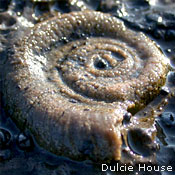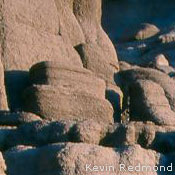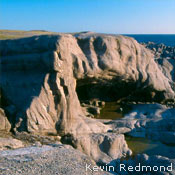The Table Point Ecological Reserve, located on the west coast of Newfoundland’s Great Northern Peninsula, protects fossils and rocks that document changes to the continental shelf of an ancient ocean.

- How to get There
- Activities
- Maps
- Services
- Fees and Schedules
- Rules and Regulations
- Permits
- Other Resources
- Contact Information
This was the scene: between 468 and 458 million years ago-a 10-million-year span that’s known as the Whiterockian portion of the Middle Ordovician Period-the Appalachian Mountains were beginning to form. At the same time, the Iapetus Ocean (ancestor of the Atlantic) was closing, and the continental shelf was collapsing and breaking apart. A carbonate belt existed along the edge of North American continent, which at the time lay across the equator. In this belt lived the distinctive brachiopods and trilobites now known as the “Toquima-Table Head Faunal Realm.”
The 1.16-km2 Table Point Ecological Reserve is one of the type localities of this ancient faunal province.

The massive dark-grey weathering limestones of the Table Point Formation (the lower unit of the Table Head Group) began to form in lagoonal waters that gradually became openly marine as the continental platform was submerged. The uppermost fossil-rich bedding plane represents a shallow bank margin that developed just before the platform was drowned. Above that, the Table Cove Formation-thin-bedded limestones and shales-mark deposition on the deep-water continental slope.
Fossils in the Table Point Ecological Reserve include ostracodes, trilobites, brachiopods, bryozoa, crinoids (sea-lilies), abundant sponges, gastropods (snails), and the spectacular large nautiloid cephalopods whose removal spurred the reserve’s creation.
Table Point lies within the Northern Peninsula Forest-Coastal Plain subregion (889 KB). It was created as a provisional ecological reserve in 1986, and fully designated in 1990.
How to get there
Table Point is a minor headland located about 14 km northeast of the community of Daniel’s Harbour (2 km north of Bellburns) on Newfoundland’s Great Northern Peninsula. The reserve is directly adjacent to the Viking Trail (Route 430).
Access to the fossils on the coastal rocks is by foot. Motorized vehicles, including ATVs are not allowed in the reserve.
Activities
The main activity that occurs in the reserve is hiking out to see the fossils-by scientists and the public. The coast can be accessed by walking from the highway (Route 430) across barrens and rocky ground to the coast. An entry permit is not required.
During the summer, whales can be spotted from the coast. Berry picking also occurs in season.
Visitors making the trip are advised to:
- Dress for open-country hiking-there is a high probability you will encounter cool wind and fog
- Carry a compass
- Exercise caution near and on the coastal rocks-they can be slippery
- Read and abide by the Rules and Regulations
Hunting and fishing are permitted in the reserve, in the appropriate seasons and with valid licences.
For more information and research guidelines, see Science and Research.
Services
There are no services in the reserve.
Fees and Schedule
There are no fees involved in visiting the reserve or obtaining the various permits.
Rules and Regulations
Biodiversity protection and habitat conservation are two of the key purposes of ecological reserves, so certain rules apply within all the reserves in the province.

The public can visit most ecological reserves for educational purposes or low-impact recreational activities, such as hiking or sightseeing. All motorized vehicles are prohibited in the reserve.
The following activities are strictly prohibited in all wilderness and ecological reserves:
- Disturbing, destroying, or removing plants, animals, or fossils
- Introducing plants, animals, or anything else to the reserve landscape
- Forestry, mining (including exploration), hydro development, agriculture, new roads, tracks, or building construction
- Driving off-road vehicles including all-terrain vehicles (ATVs)
Read the official reserve regulations:
- Fossil Ecological Reserve Regulations
- Table Point Ecological Reserve Order
- Wilderness and Ecological Reserves Act
Adobe® Acrobat® Reader software can be used for viewing PDF documents. Download Acrobat® Reader for free
